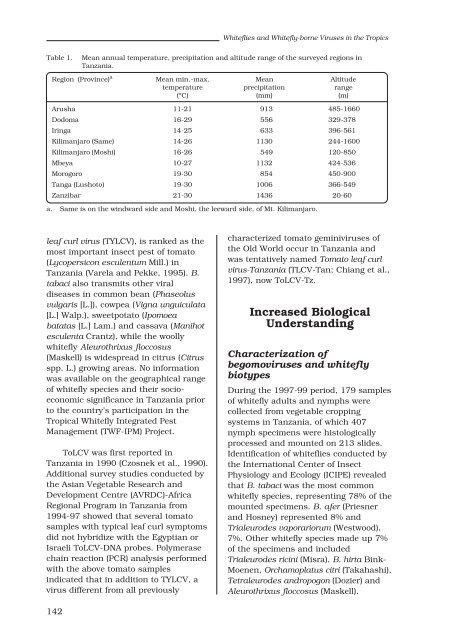Whitefly and whitefly-borne viruses in the tropics : Building a ... - cgiar
Whitefly and whitefly-borne viruses in the tropics : Building a ... - cgiar
Whitefly and whitefly-borne viruses in the tropics : Building a ... - cgiar
Create successful ePaper yourself
Turn your PDF publications into a flip-book with our unique Google optimized e-Paper software.
leaf curl virus (TYLCV), is ranked as <strong>the</strong><br />
most important <strong>in</strong>sect pest of tomato<br />
(Lycopersicon esculentum Mill.) <strong>in</strong><br />
Tanzania (Varela <strong>and</strong> Pekke, 1995). B.<br />
tabaci also transmits o<strong>the</strong>r viral<br />
diseases <strong>in</strong> common bean (Phaseolus<br />
vulgaris [L.]), cowpea (Vigna unguiculata<br />
[L.] Walp.), sweetpotato (Ipomoea<br />
batatas [L.] Lam.) <strong>and</strong> cassava (Manihot<br />
esculenta Crantz), while <strong>the</strong> woolly<br />
<strong>whitefly</strong> Aleurothrixus floccosus<br />
(Maskell) is widespread <strong>in</strong> citrus (Citrus<br />
spp. L.) grow<strong>in</strong>g areas. No <strong>in</strong>formation<br />
was available on <strong>the</strong> geographical range<br />
of <strong>whitefly</strong> species <strong>and</strong> <strong>the</strong>ir socioeconomic<br />
significance <strong>in</strong> Tanzania prior<br />
to <strong>the</strong> country’s participation <strong>in</strong> <strong>the</strong><br />
Tropical <strong>Whitefly</strong> Integrated Pest<br />
Management (TWF-IPM) Project.<br />
ToLCV was first reported <strong>in</strong><br />
Tanzania <strong>in</strong> 1990 (Czosnek et al., 1990).<br />
Additional survey studies conducted by<br />
<strong>the</strong> Asian Vegetable Research <strong>and</strong><br />
Development Centre (AVRDC)-Africa<br />
Regional Program <strong>in</strong> Tanzania from<br />
1994-97 showed that several tomato<br />
samples with typical leaf curl symptoms<br />
did not hybridize with <strong>the</strong> Egyptian or<br />
Israeli ToLCV-DNA probes. Polymerase<br />
cha<strong>in</strong> reaction (PCR) analysis performed<br />
with <strong>the</strong> above tomato samples<br />
<strong>in</strong>dicated that <strong>in</strong> addition to TYLCV, a<br />
virus different from all previously<br />
142<br />
Whiteflies <strong>and</strong> <strong>Whitefly</strong>-<strong>borne</strong> Viruses <strong>in</strong> <strong>the</strong> Tropics<br />
Table 1. Mean annual temperature, precipitation <strong>and</strong> altitude range of <strong>the</strong> surveyed regions <strong>in</strong><br />
Tanzania.<br />
Region (Prov<strong>in</strong>ce) a<br />
Mean m<strong>in</strong>.-max. Mean Altitude<br />
temperature precipitation range<br />
(°C) (mm) (m)<br />
Arusha 11-21 913 485-1660<br />
Dodoma 16-29 556 329-378<br />
Ir<strong>in</strong>ga 14-25 633 396-561<br />
Kilimanjaro (Same) 14-26 1130 244-1600<br />
Kilimanjaro (Moshi) 16-26 549 120-850<br />
Mbeya 10-27 1132 424-536<br />
Morogoro 19-30 854 450-900<br />
Tanga (Lushoto) 19-30 1006 366-549<br />
Zanzibar 21-30 1436 20-60<br />
a. Same is on <strong>the</strong> w<strong>in</strong>dward side <strong>and</strong> Moshi, <strong>the</strong> leeward side, of Mt. Kilimanjaro.<br />
characterized tomato gem<strong>in</strong>i<strong>viruses</strong> of<br />
<strong>the</strong> Old World occur <strong>in</strong> Tanzania <strong>and</strong><br />
was tentatively named Tomato leaf curl<br />
virus-Tanzania (TLCV-Tan; Chiang et al.,<br />
1997), now ToLCV-Tz.<br />
Increased Biological<br />
Underst<strong>and</strong><strong>in</strong>g<br />
Characterization of<br />
begomo<strong>viruses</strong> <strong>and</strong> <strong>whitefly</strong><br />
biotypes<br />
Dur<strong>in</strong>g <strong>the</strong> 1997-99 period, 179 samples<br />
of <strong>whitefly</strong> adults <strong>and</strong> nymphs were<br />
collected from vegetable cropp<strong>in</strong>g<br />
systems <strong>in</strong> Tanzania, of which 407<br />
nymph specimens were histologically<br />
processed <strong>and</strong> mounted on 213 slides.<br />
Identification of whiteflies conducted by<br />
<strong>the</strong> International Center of Insect<br />
Physiology <strong>and</strong> Ecology (ICIPE) revealed<br />
that B. tabaci was <strong>the</strong> most common<br />
<strong>whitefly</strong> species, represent<strong>in</strong>g 78% of <strong>the</strong><br />
mounted specimens. B. afer (Priesner<br />
<strong>and</strong> Hosney) represented 8% <strong>and</strong><br />
Trialeurodes vaporariorum (Westwood),<br />
7%. O<strong>the</strong>r <strong>whitefly</strong> species made up 7%<br />
of <strong>the</strong> specimens <strong>and</strong> <strong>in</strong>cluded<br />
Trialeurodes ric<strong>in</strong>i (Misra), B. hirta B<strong>in</strong>k-<br />
Moenen, Orchamoplatus citri (Takahashi),<br />
Tetraleurodes <strong>and</strong>ropogon (Dozier) <strong>and</strong><br />
Aleurothrixus floccosus (Maskell).
















